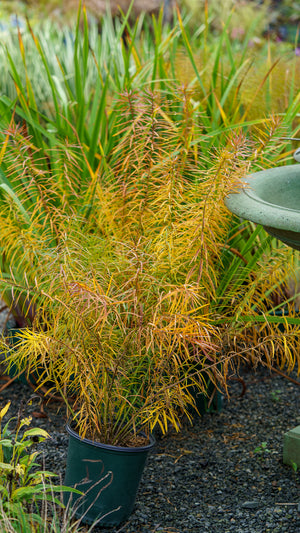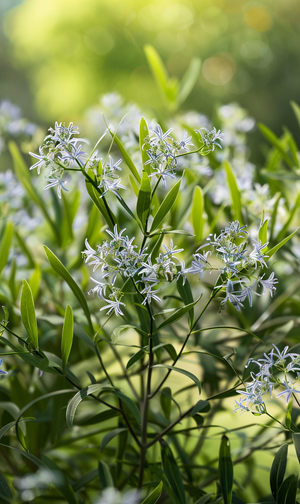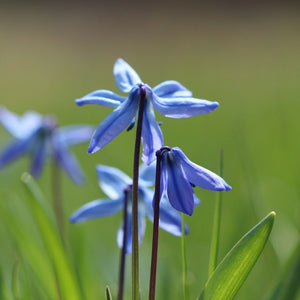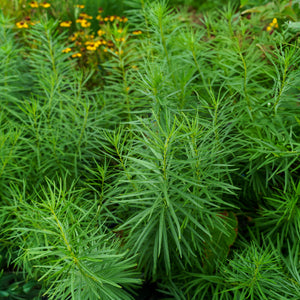The Amsonia Guide
Amsonia, commonly known as Bluestar, is a resilient and versatile perennial prized for its delicate star-shaped flowers, feathery foliage, and brilliant golden fall color. Native to North America, Amsonia thrives in a variety of garden settings, from borders and meadows to woodland gardens. With a graceful, bushy habit and seasonal interest, this low-maintenance plant is a favorite among gardeners seeking structure, color, and wildlife-friendly blooms. Here’s everything you need to know about growing and caring for Amsonia.

About
Amsonia is a genus in the Apocynaceae family, consisting of several species that are valued for their three-season appeal. The plant produces clusters of small, pale blue flowers in spring, followed by dense, finely textured foliage that remains attractive throughout the growing season. In autumn, the foliage turns a vibrant golden-yellow, adding a burst of warm color to the landscape.
Popular species include Amsonia hubrichtii, known for its fine, thread-like leaves and exceptional fall color; Amsonia tabernaemontana, which has broader leaves and a more upright growth habit; and compact cultivars like Amsonia 'Blue Ice', which provide dense floral displays in smaller garden spaces. Amsonia 'Storm Cloud', with its dark stems and sky-blue flowers, and Amsonia 'String Theory', a more compact selection of A. hubrichtii, add variety to the available selections.
Amsonia is highly adaptable, tolerating a range of soil types and moisture levels. It is resistant to pests and diseases and is unpalatable to deer, making it an excellent choice for low-maintenance landscapes. Whether used as a backdrop for other perennials or planted en masse for a striking visual effect, Amsonia is a valuable addition to any garden.

PLANTING
- USDA Hardiness Zones: Most Amsonia species thrive in Zones 4-9, offering excellent cold tolerance.
- Soil: Prefers well-drained soil but can tolerate clay, loam, and sandy conditions. Amsonia does best in moderately fertile soil with consistent moisture.
- Sunlight: Grows well in full sun to partial shade. Full sun encourages stronger stems and more vibrant fall color, while partial shade may result in a looser, more open habit.
- Watering: Water regularly during the first growing season to establish deep roots. Once established, Amsonia is drought-tolerant but benefits from occasional watering during prolonged dry periods.
- Spacing: Space plants 18-24 inches apart to allow for natural spreading and airflow.
- Planting Time: Plant in early spring or fall when temperatures are mild, allowing plants to establish before extreme weather conditions.
To plant Amsonia, loosen the soil and mix in compost for added nutrients. Dig a hole slightly larger than the root ball, place the plant in the hole, and backfill with soil. Water thoroughly after planting to encourage root establishment.

CARE
- Watering: Once established, Amsonia requires minimal watering, though it benefits from supplemental moisture in hot, dry conditions.
- Pruning: Cutting Amsonia back by one-third after flowering can help maintain a more compact shape and prevent flopping. In late fall or early spring, remove dead stems to encourage fresh growth.
- Fertilizing: Generally does not require heavy fertilization. A light application of compost or balanced fertilizer in early spring can promote healthy growth.
- Pests & Diseases: Amsonia is highly resistant to pests and diseases, making it a worry-free addition to the landscape.
- Dividing: Divide clumps every 3-5 years in early spring or fall to maintain vigor and propagate new plants.

HOW TO USE
Amsonia’s adaptability and seasonal interest make it an excellent choice for various garden applications:
- Pollinator Gardens: The nectar-rich blooms attract butterflies and beneficial insects in spring.
- Mass Planting: Large groupings create a stunning visual effect, particularly in fall when the foliage turns golden-yellow.
- Borders & Edging: Compact varieties like Amsonia 'Blue Ice' and Amsonia 'Starstruck' work well along pathways and mixed borders.
- Native & Meadow Gardens: Amsonia pairs well with other native perennials such as echinacea, rudbeckia, and grasses.
- Low-Maintenance Landscapes: Its resistance to deer, drought, and disease makes Amsonia ideal for easy-care garden designs.

Common Questions
- Is Amsonia deer resistant? Yes, Amsonia is highly deer-resistant due to its milky sap, which deer find unpalatable.
- Do you cut back Amsonia in the fall? Cutting back Amsonia in the fall is optional. Many gardeners leave the stems for winter interest and remove them in early spring.
- How long does Amsonia bloom? Amsonia typically blooms for 3-4 weeks in mid-to-late spring, depending on the climate.
- How to divide Amsonia? Divide clumps in early spring or fall by carefully digging up the plant, separating the roots, and replanting in well-prepared soil.
- How to grow Amsonia? Provide full sun to partial shade, well-draining soil, and occasional watering in dry conditions for best results.
- Is Amsonia invasive? No, Amsonia is not invasive. It spreads slowly over time but does not aggressively take over garden spaces.
- Is Amsonia poisonous to dogs? No, Amsonia is not considered toxic to dogs, making it a safe choice for pet-friendly gardens.
- Is Amsonia poisonous to cats? No, Amsonia is not known to be toxic to cats and is generally safe around pets.
Conclusion
Amsonia is a resilient, low-maintenance perennial that provides stunning three-season interest with its delicate spring flowers, lush summer foliage, and brilliant fall color. Whether used as a pollinator-friendly plant, a structural backdrop in a mixed border, or a mass-planted display, Amsonia offers beauty and reliability to any garden. With selections like Amsonia hubrichtii, Amsonia 'Blue Ice', and Amsonia tabernaemontana 'Storm Cloud', there is an Amsonia variety suited for every landscape. Explore our collection and bring the charm of Bluestar to your garden.
The Amsonia Collection
Sold Out
Sold Out
Sold Out



